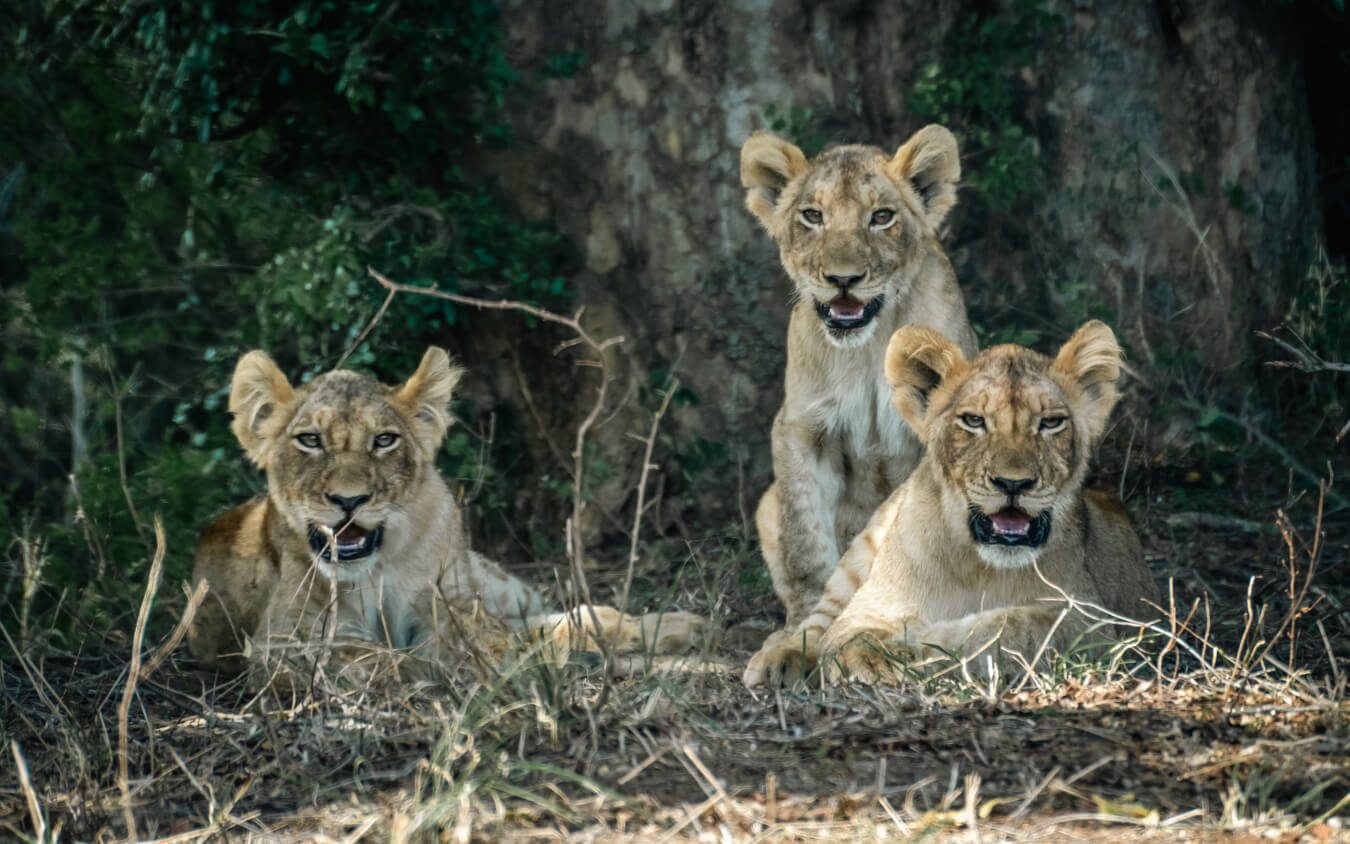We were living under a rock for the longest time and only got to know about self-drive safaris while planning our trip to South Africa and Victoria Falls. And I can’t explain just how glad we were to experience it!
Doing a self-drive in Kruger National Park is one of the best flexible and cost-efficient ways to explore the incredible wildlife of South Africa. Unlike guided safaris, a self-drive safari gives you full control over your route and pace, making for a more personal experience.
In this guide, we’ll cover everything you need to know to plan your time in Kruger—from the best routes, where to stay, what to carry, and all our best tips!
- Why Choose to Self-Drive in Kruger National Park?
- Disadvantages of a Self-Drive Safari in Kruger
- Best Time to Visit Kruger for a Self-Drive Safari
- How to Reach Kruger for a Self-Drive Safari
- What Type of Car Do You Need for Kruger?
- Entry Fees & Permits for Kruger
- Gate Times & Entry Restrictions
- What is it Like to Self-Drive in Kruger National Park?
- How to Plan Your Self-Drive in Kruger
- Best Accommodation Options for Self-Drivers
- Best Self-Drive Safari Routes in Southern Kruger
- Self-Drive Kruger Itineraries and Budget
- Food & Fuel Stops Inside Kruger
- Top Tips for a Successful Self-Drive Safari
- What to Wear on a Self-Drive Safari in Kruger National Park?
- What to pack for Kruger?
Why Choose to Self-Drive in Kruger National Park?
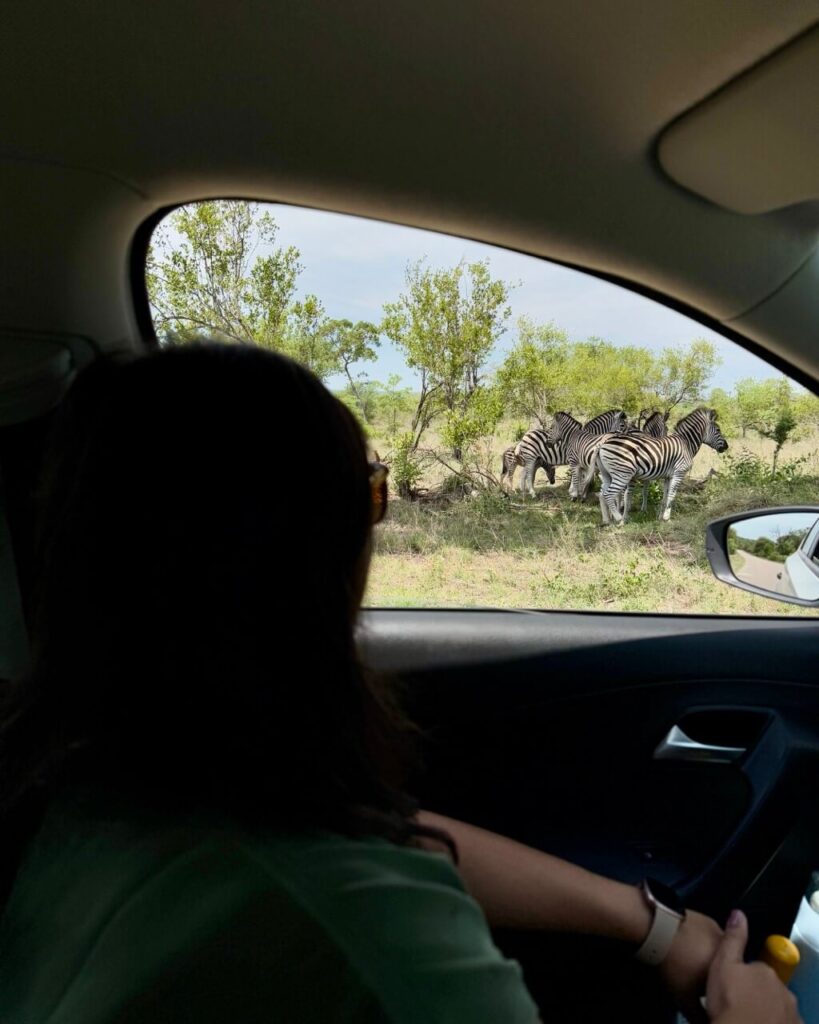
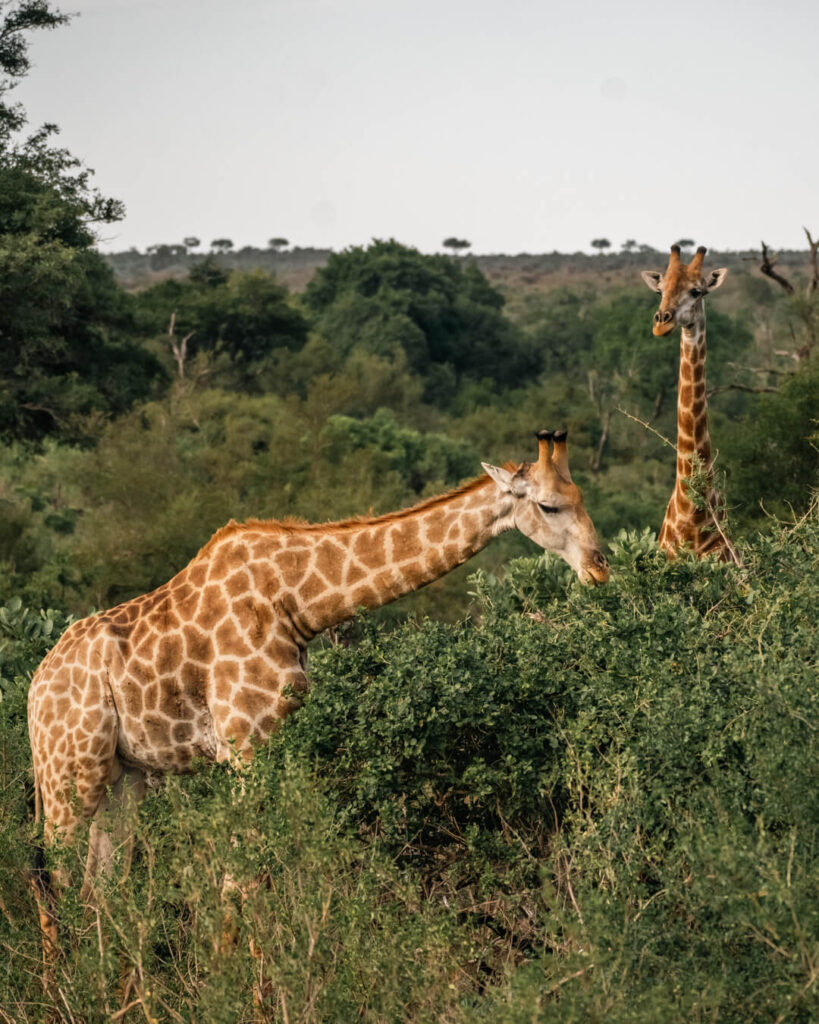
While guided safaris have their advantages, self-driving offers freedom, flexibility, and is a more budget-friendly way to explore one of the world’s greatest wildlife reserves. Here’s why it might be the perfect choice for you:
1. Renting and driving are cheap and easy: Renting a car is very easy and cheap in South Africa. International Driving Permits are not needed either if your licence is in the latin alphabet. Driving is on the left side, just like in the UK, Australia, India and so on. If you’re from such countries, it’s going to be so easy! And if you’re not, you’ll soon get used to it. Plus, the roads are superb and people follow traffic rules in South Africa!
2. Complete flexibility & control: You can choose your own routes, observe an animal as long as you like, and start or end your drive whenever you see fit.
3. More affordable than guided safaris: Guided safaris cost about USD 100-USD 300 per person per drive, whereas a self-drive in Kruger only requires you to pay for entry fees, fuel, and your rental car. You can choose to stay at a budget accommodation inside or outside Kruger and control how much you spend.
4. Road conditions are fabulous: Kruger has an excellent network of tarred and gravel roads, meaning no 4WD is required. Even a small car can comfortably navigate most parts of the park.
5. Clear Signage & Easy Navigation: The park is so well signposted that it is tough to get lost here. To navigate, you can buy the Kruger Park Map (which is excellent, by the way, but quite pricey) to navigate, use Google Maps (just download it prior) and even get real-time sighting updates from fellow travellers using the Latest Sightings app. Kruger is literally designed for self-drive safaris.
6. More Intimate & Personal Wildlife Experience: Imagine seeing a lion from your car! Isn’t that crazy? There is a unique thrill in spotting wildlife on your own with only your travel companions in the car, making it the perfect road trip!
7. Weather doesn’t matter: We were in Kruger in December when the temperature was 47°C. It was blazing. One evening we took a safari and got so tired because of the heat. Yet when we were in the car, we hardly even felt it because we had the AC on. So if it’s super cold or hot in the national park, you’ll be comfortable in your car.
Disadvantages of a Self-Drive Safari in Kruger
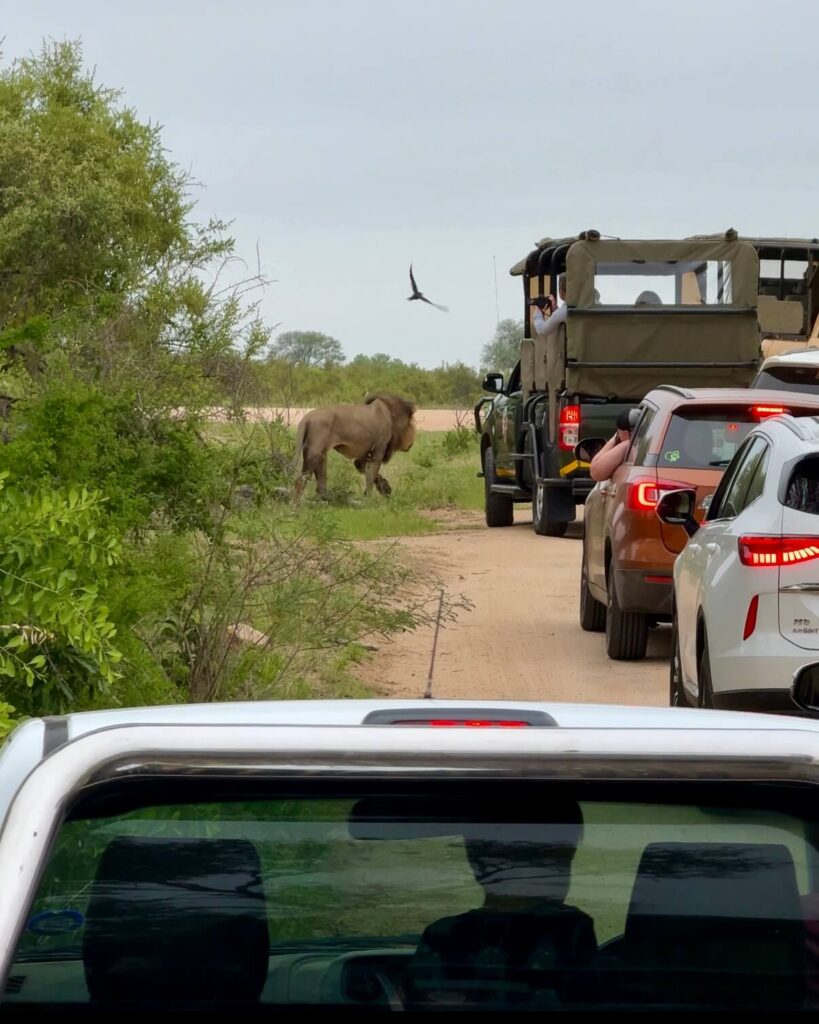
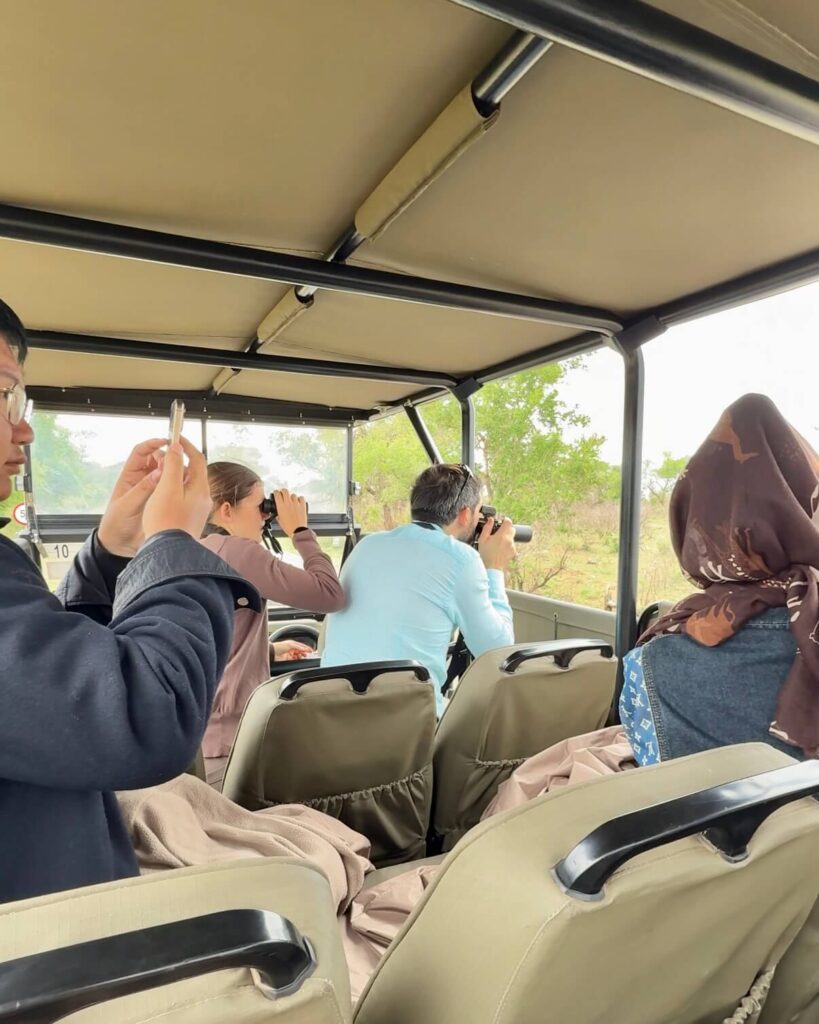
While self-driving is fantastic, it may not be for everyone, and there are certain disadvantages.
- Expert wildlife guidance is not available— Guides and rangers understand animal behaviour and communicate with each other, which increases the chances of special sightings. Plus, you gain a lot of knowledge about the animals from them that you wouldn’t get on a self-drive.
- Height of Safari Vehicles: Since safari vehicles are higher off the ground, it’s easier to spot animals even if a smaller car is blocking the view.
- No luxury service — Self-drives are raw and casual and you have to manage everything yourself. You need to figure out the routes yourself; you don’t get snacks on the go, binoculars, or any service at all. So if you’re a luxury traveller looking for the perfect safari experience, then a self-drive might not be for you.
Tip: It is best to combine self-drives with guided safaris during your time in Kruger so you can experience the best of both.
Best Time to Visit Kruger for a Self-Drive Safari
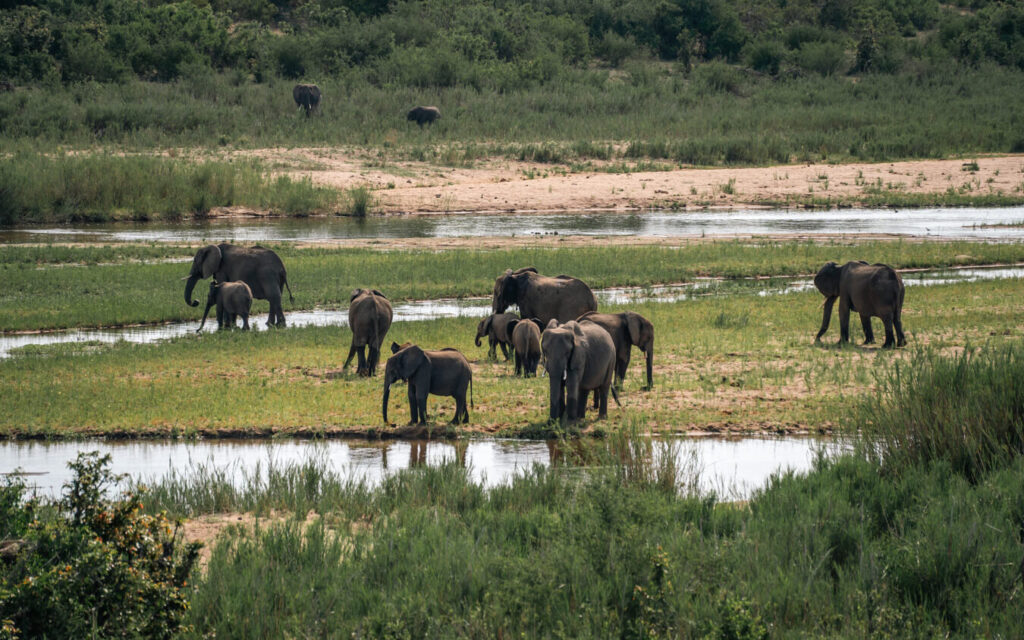
The best time to visit Kruger National Park for a self-drive safari depends on what kind of experience you’re looking for.
May to October: The dry season from May to October is great for wildlife viewing in general, as the temperatures are cooler and vegetation is less, making animals easier to spot. However, these are also the peak game-viewing months so many people like to visit during this time and stays can be expensive because of high demand.
November to April: The wet season makes vegetation green and tall so wildlife viewing can be slightly harder. The weather is scorching when it’s not raining. However, this time period has fewer crowds & lower accommodation prices and a lot of baby animals all around, which are so cute to see.
However, remember that late December is high season as school holidays start and locals make their way to Kruger.
Tip: There is no bad time to go for a self-drive safari except during the holiday season when it gets insanely crowded. We were there in late December, just before the holiday season, at what would be called a bad time to visit. It was hot and vegetation was tall but we still had a great animal viewing experience!
How to Reach Kruger for a Self-Drive Safari
To reach Kruger by air, you can fly into Kruger Mpumalanga International Airport (MQP), which is just 30–45 min from the southern gates or Skukuza Airport (SZK) inside Kruger, ideal for direct access. You can rent a car from the airport or from Skukuza Rest Camp.
However, flights to Kruger can get expensive so the other option is to arrive in Johannesburg OR Tambo (JNB), rent a car from the airport itself and drive 5 hours to Kruger.
What Type of Car Do You Need for Kruger?

One of the best things about self-driving in Kruger is that you can easily do the trip in all kinds of cars. The park is well-maintained, with both tarred roads and gravel routes. However, choosing the right type of car can make your safari experience much more comfortable and rewarding.
Sedan and Hatchback: The best budget option! This is what we chose as well and didn’t have any trouble at all. However, the disadvantage is that having lower ground clearance means you won’t get the best views when spotting animals in tall grass or when another car is parked right in front of the animals. Also, some gravel roads may be bumpy!
SUV: If your budget allows it, then it’s a great choice because you’ll have better wildlife visibility from the higher ground clearance and higher seats. Plus, your drive will be smoother on gravel roads and you’ll get better traction in muddy conditions. A 4×4 is typically not needed!
We booked a car from DiscoverCars per usual because they have superb offers, excellent car insurance with easy claims and a super speedy customer service response. Highly recommend them for all your international car rentals!
Entry Fees & Permits for Kruger
When you enter Kruger, you need to park your car at the office, submit a filled indemnity form and pay a daily conservation fee per person (only cards are accepted).
During peak season (late December) and public holidays, we highly recommend that you pre-book your entry permit online. Also, if staying inside the park, your accommodation booking includes entry permission (fees still apply).
Remember to keep the permit safely, as you will need to show it while entering and exiting the park.
As of 2025, the fees are:
- International Visitors: R535 per adult / R267 per child per day
- SADC Nationals: R257 per adult / R128 per child per day
- South African Citizens & Residents: R128 per adult / R64 per child per day
Wild Card: If you’re a local planning to visit Kruger for more than a few days or explore other South African National Parks, a Wild Card might be a more cost-effective option, as it gives you unlimited entry to Kruger and other SANParks reserves without paying daily fees. However, as an international traveller visiting for a few days, the price is exorbitant and just not worth it. Check the latest wildcard rates here.
Gate Times & Entry Restrictions
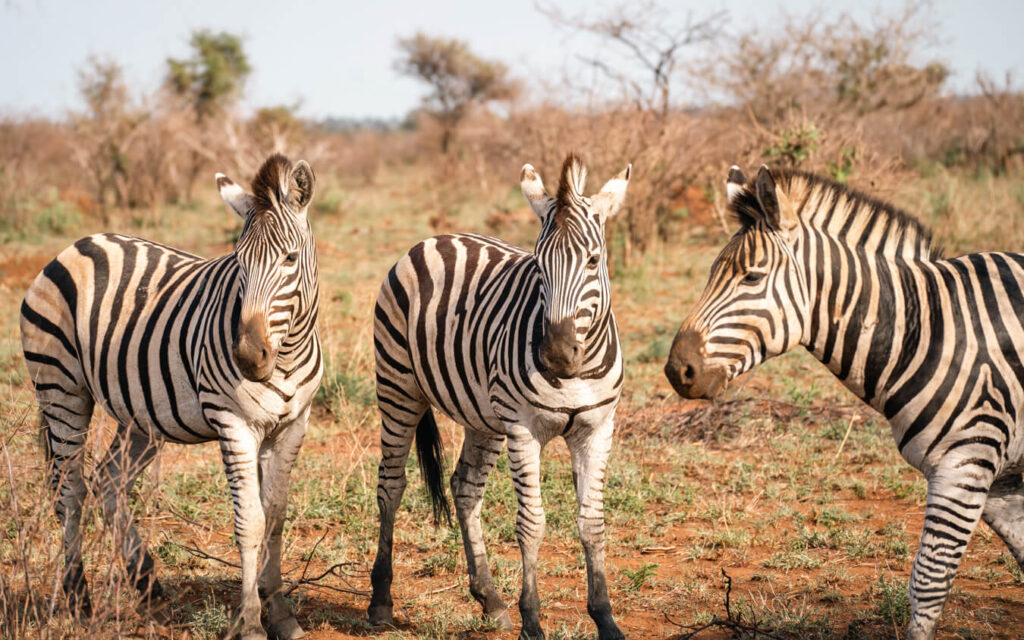
Kruger has strict gate opening & closing times, which vary by season.
- Summer (Nov–Feb): 5:30 AM – 6:30 PM
- April, August and September: 6:00 AM – 6:00 PM
- Winter (May–July): 6:00 AM – 5:30 PM
- October: 5:30 AM – 6:00 PM
Find the updated timings here.
Important: As a self-drive visitor staying outside the park, you must exit the park before closing time. Even if you’re staying inside a rest camp, know that they have timings as well and you need to be inside the camp gates at closing time. Do take this very seriously in order to not have to pay fines!
What is it Like to Self-Drive in Kruger National Park?

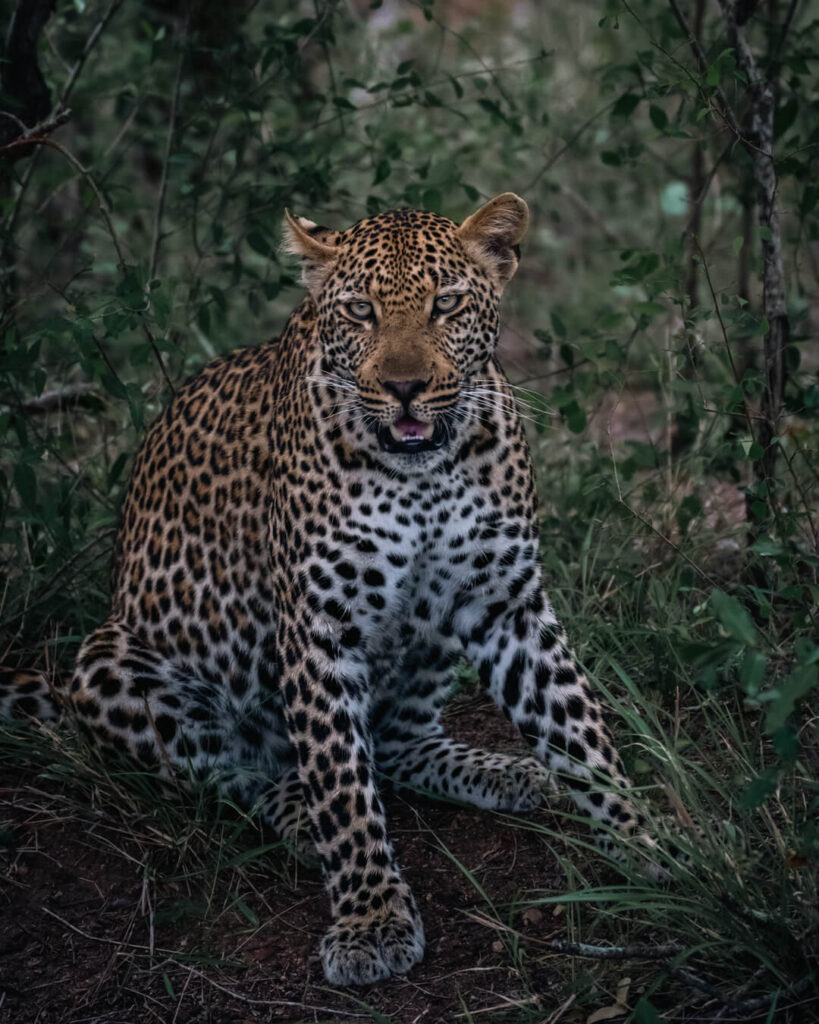
We love exploring places independently, and being able to do a safari by ourselves was absolutely amazing. However, before we went, we were pretty clueless about the experience. So here are a few things you must know.
- Off-roading is not allowed: You must’ve seen big jeeps go off-road during African safaris. However, no one can do this in Kruger—not safari jeeps, not private cars.
- You are not allowed to get out of your vehicle: While self-driving within Kruger National Park, you aren’t allowed to get out of your vehicle. So when you spot that cute animal, you shouldn’t get out of your car even if it is far, far away.
Remember that wild animals see a vehicle with a human in it as a huge beast (bigger than themselves) so they don’t attack the vehicle. But the moment you get out of the car, you’re recognisable as a human (a much smaller being than a car) and therefore more prone to an animal attack. So it is best to keep your car window closed and even if you do slide your window down to view an animal, do not put out your arms to take photos, as it could be dangerous. - You are allowed to get out at rest camps: No, you don’t need to be confined to your car the entire time. There are rest camps in Kruger where you can get out of your vehicle.
- Rest camps inside Kruger have restaurants and toilets: These rest camps have toilets. Some also have restaurants, petrol pumps (gas stations), shops, etc., so you can use them to refresh yourself and stretch your legs during your self-drive trip in Kruger.
- You need a full day for your self-drive in Kruger National Park: While you can enter Kruger for a few hours to drive around, it is quite useless and a waste of time and money. You need at least one full day to drive around. Though the driving distance for each day might not be a lot, driving around Kruger is quite slow (as it should be), and you need to be patient to see animals.
All in all, it’s like any regular day of exploring a new country. Just that you’ll be in the car for most of the day; listen to your favourite songs, eat a lot of snacks, keep a lookout for animals, and just have the best day ever.
How to Plan Your Self-Drive in Kruger
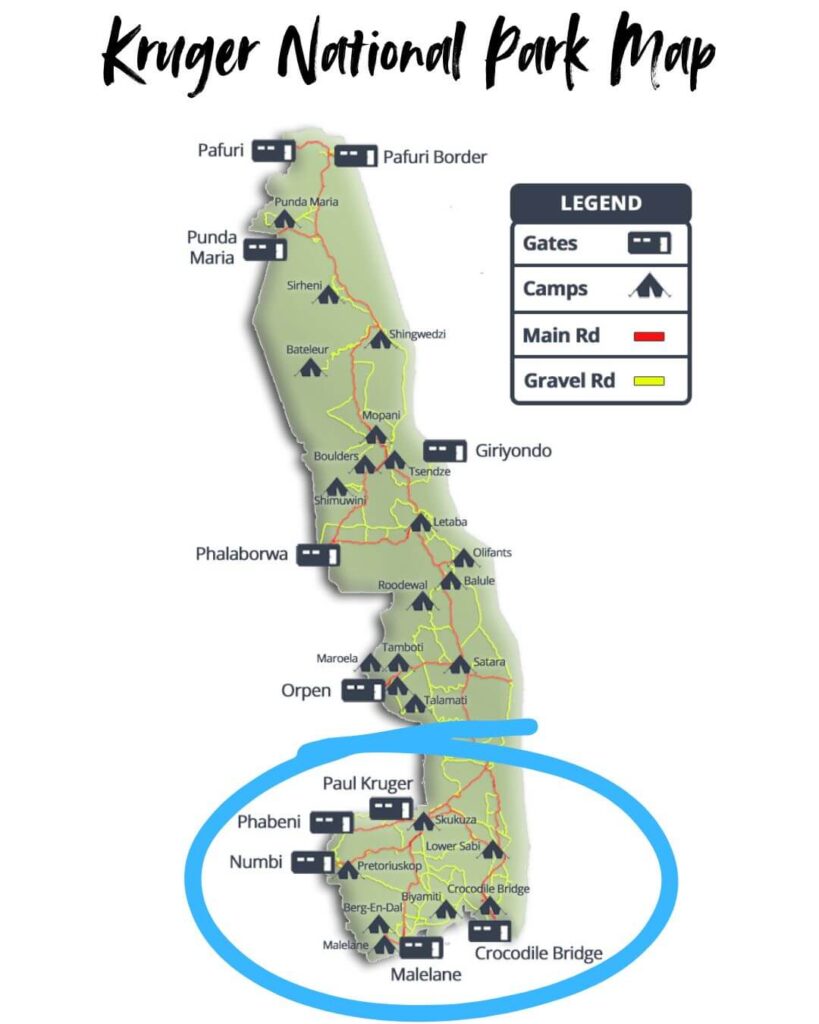
Choosing your area of exploration and the preferred Kruger gates is extremely important for planning your trip.
Why?
Because Kruger National Park is huge! It is the largest game reserve in Africa, covering nearly 20,000 square kilometres, which is just about the size of Slovenia. Given its size, planning your route in advance is key.
The park is divided into three main regions: Southern, Central and Northern Kruger.
Most first-time visitors stick to South Kruger within popular areas like Skukuza, Lower Sabie, and Crocodile Bridge because these areas have the highest concentration of wildlife, including lions, elephants, and rhinos.
So from now on, in this post, I will be focusing on this region only!
However, if you’re planning to spend a longer time in Kruger, you might consider heading towards Central Kruger for the open savannah landscapes, which are good for predator sightings. With more time, head even more north to northern Kruger, known for excellent birdwatching.
Best Park Gates in Southern Kruger
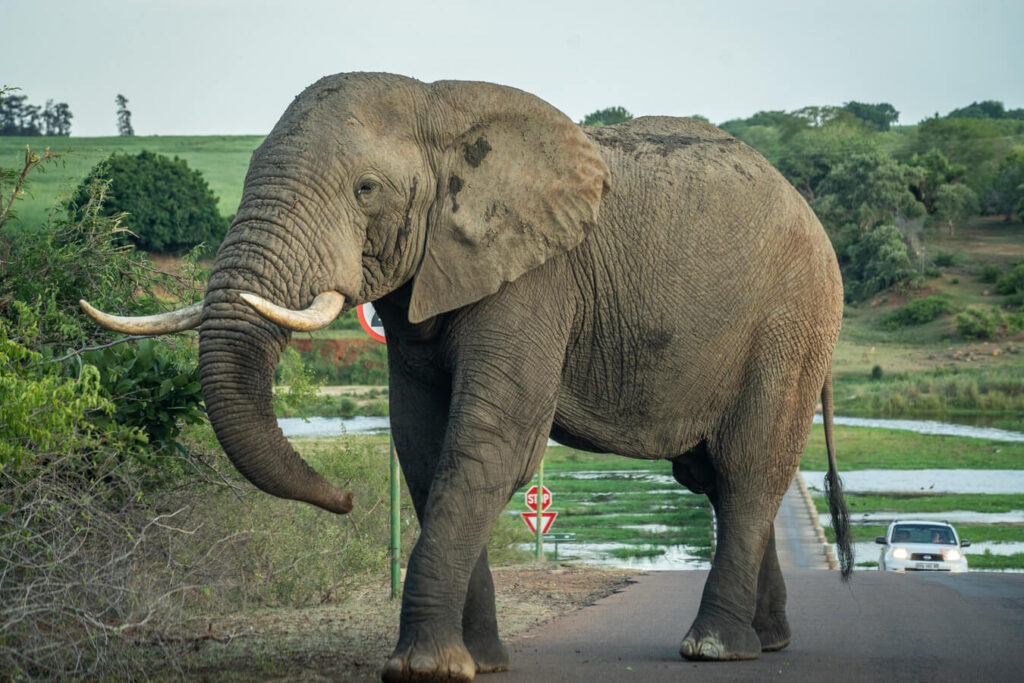
Kruger has nine main entry gates but we will only be talking about the southern ones, perfect for your first visit. Choose the one that best fits your itinerary:
- Paul Kruger Gate: Ideal for first-time visitors, as it’s got a lot of game around the area. Cost-efficient SANParks guided safaris can be arranged through this gate.
- Crocodile Bridge Gate (Southeast)—A very popular gate for budget and mid-range travellers, great for spotting lions and cheetahs early in the morning. Cost-efficient SANParks guided safaris can be arranged through this gate.
Pro Tip: Gates open early (5:30 AM – 6:00 AM, depending on the season). Arrive as early as possible for the best wildlife sightings – much earlier than opening time.
However, if you’d like to not wake up so early and get stuck in a queue at the gate, then arrive at the gate half an hour after opening time. This is what we did, and we were promptly let in.
Best Accommodation Options for Self-Drivers
Budget-Friendly Options
Stay at the Kruger National Park SANParks rest camps the way locals do it. This is the most budget-friendly way to experience the park. The rest camps have camping grounds as well as huts and cottages with all basic furnishings for a comfortable stay, including air conditioning. The kitchen, however, is communal!
The main advantage of staying inside the park is that you don’t have to queue up at the Kruger’s gates early in the morning. So you can easily start your drive before all the vehicles arrive in the morning.
- Crocodile Bridge Rest Camp – Great for doing the inexpensive 21-seater game drives but it doesn’t have a restaurant or swimming pool.
- Lower Sabie Rest Camp – Great for wildlife sightings along the Sabie River – perfect views.
- Skukuza Rest Camp – Largest camp with good facilities, including 2 swimming pools and a car rental facility.
Where to eat: You can either cook your own food or eat at the restaurant in the rest camp if it has one.
Mid-Range Options
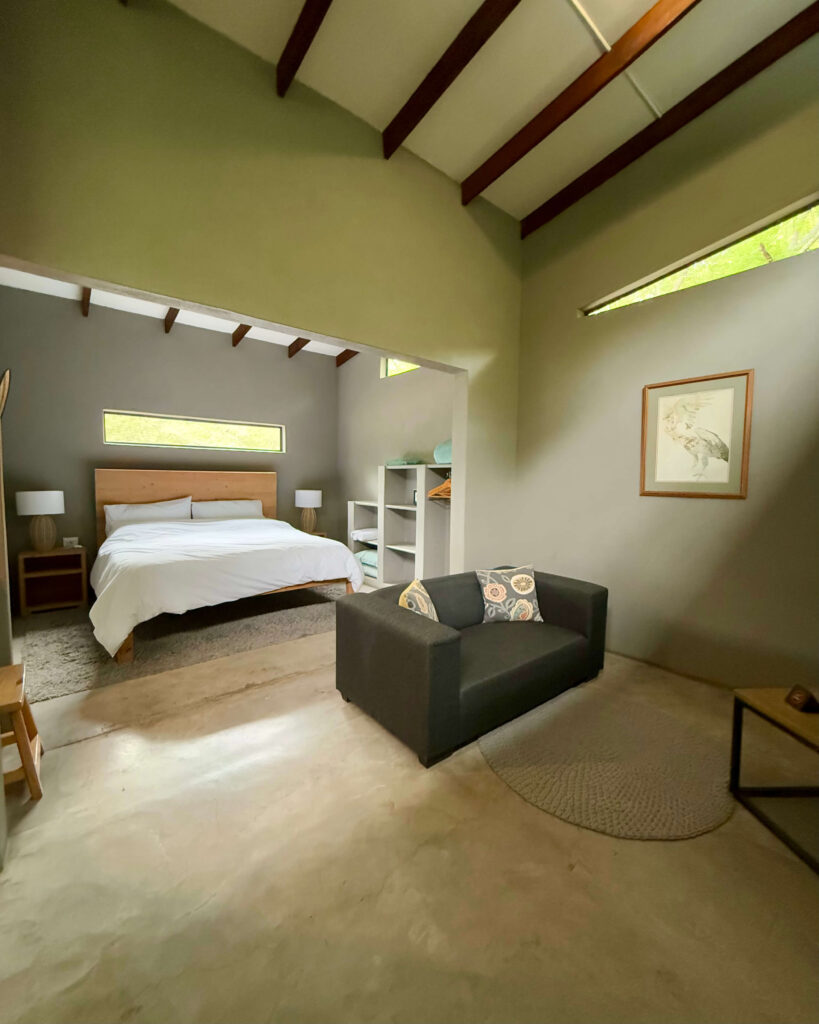
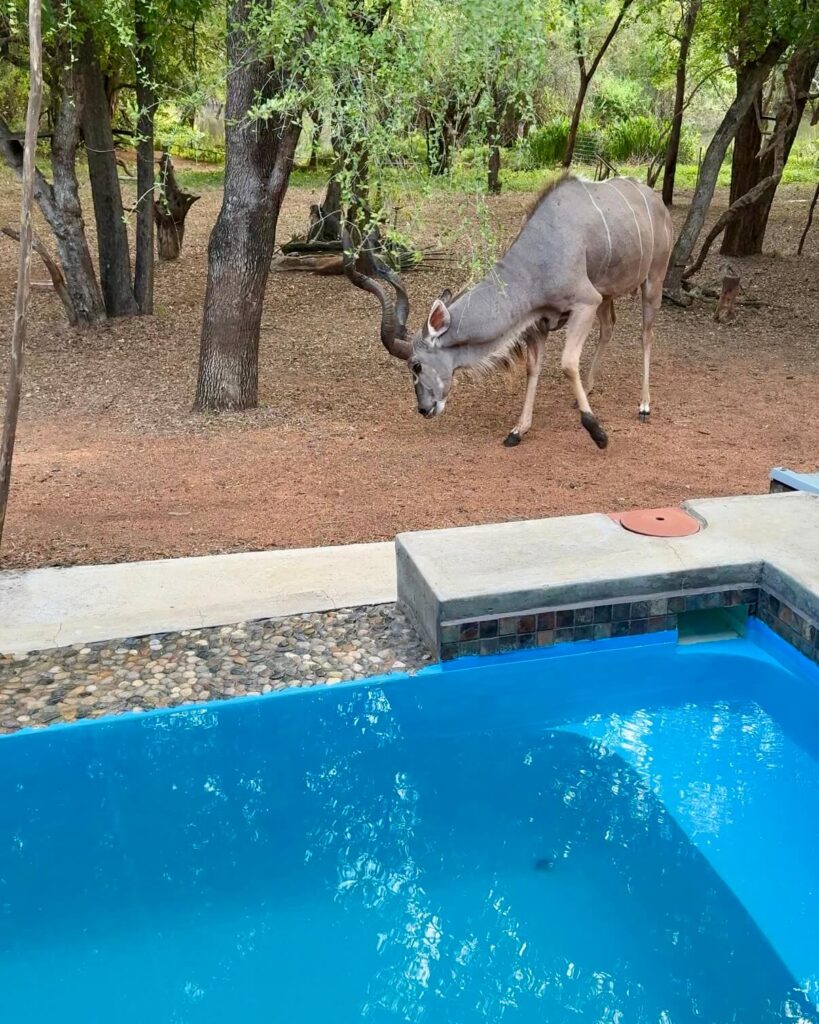
For a mid-range stay, I highly recommend staying near the Crocodile Bridge Gate.
While the best option is to stay as close to the gate as possible, there aren’t a lot of stays there. There is a wildlife conservancy about 20 km away, a 30-minute drive from Crocodile Bridge Gate, called Marloth Park, which has a lot of options to choose from and makes for an excellent area to stay. The conservancy has lodges without fences so animals come right up to the pool areas and outside the rooms, just like they would if you stayed inside Kruger.
Here are some great accommodation options:
- Crocodile Bridge Safari Lodge: A charming tented lodge with views over the river and a superb location just outside Crocodile Bridge Gate.
- Grace of Africa Lodge, Marloth Park: An adults-only lodge that gives all the luxury feels at a reasonable price.
- Dream of Africa Bush Lodge, Marloth Park: This is where we stayed. The couple who run the place are the most helpful, sweetest people we’ve met and the food was out of this world—simple, nutritious and delicious. It is located right in front of the river bordering Kruger, so animals come by the pool area all the time. We loved it but beware that in the summers the AC doesn’t do a great job.
Alternatively, you can also stay near Paul Kruger Gate at hotels like Kruger Gate Hotel.
Tip: I highly recommend getting the breakfast and dinner option (half board) so that when you return to your hotel in the evening, your dinner is ready and you don’t have to go looking for places to eat. There aren’t many restaurants in these areas.
Luxury Safari Lodges
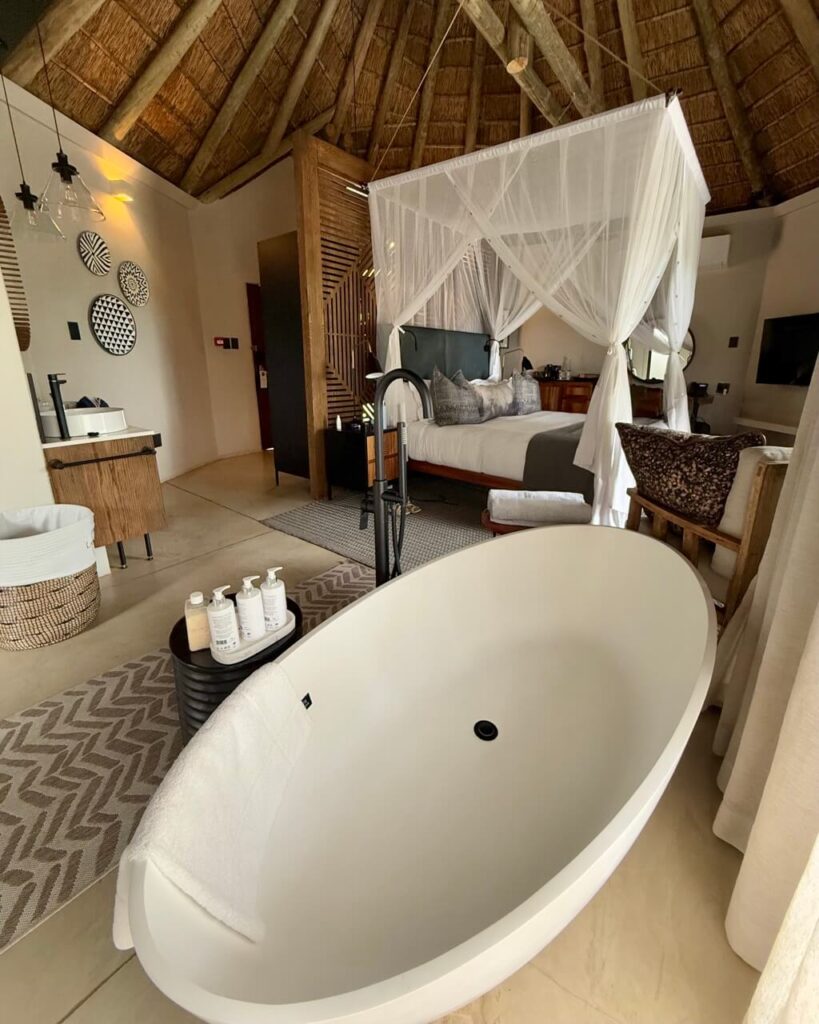
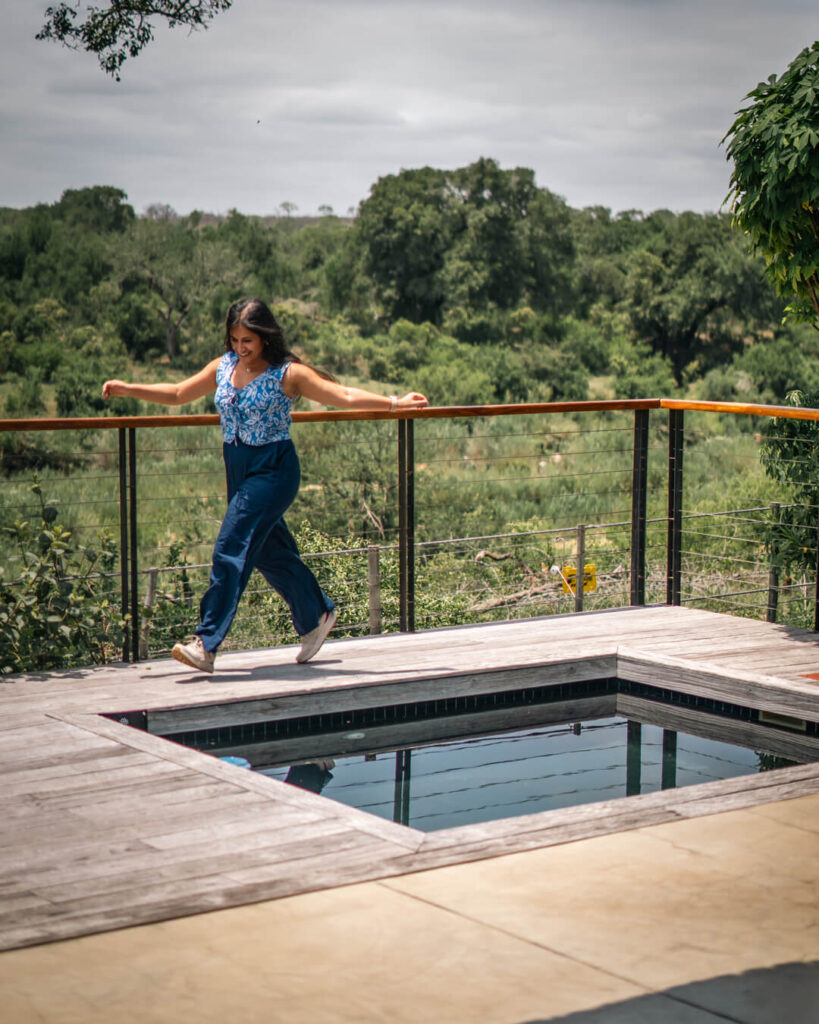
For a luxury safari experience, it is best to stay at the lodges inside Kruger National Park. You can even opt to stay outside like we did (still a great experience) or even experience Sabi Sands nearby. I’ve provided some good options below:
- Jock Safari Lodge (inside Kruger): luxurious suites, private plunge pools, private decks, and fantastic game viewing. It’s located in a prime concession area, so you get exclusivity with fewer vehicles around.
- Hamilton’s Tented Camp (inside Kruger): This is a dream for couples! The luxury tents have outdoor bathtubs, and the lodge exudes old-world safari charm with excellent service and stunning views.
- Rhino Walking Safaris (inside Kruger): If you want a walking safari experience, this is the best choice. You’ll get up close to wildlife in a way that a traditional game drive can’t offer. If you want a proper lodge experience, stay at their sister property, Rhino Post Safari Lodge.
- Kruger Shalati Train on the Bridge (inside Kruger): A hotel built in train carriages parked on a bridge. It’s a super unique stay!
- Leopard Sands Kruger Park (outside Kruger): While staying inside Kruger makes for the best experience, we stayed outside Paul Kruger Gate at Leopard Sands Kruger Park, which is an all-inclusive hotel (minus alcohol). Since it is a Marriott-affiliated hotel, we stayed here to avail our Marriott Bonvoy Points. So if you’d like to save a buck or collect Marriott Bonvoy points, it’s a fantastic place to stay.
- Sabi Sands: Lastly, instead of spending the next one or two nights in Kruger, you can also alternatively head to Sabi Sands Nature Reserve nearby. Since it is a private reserve, safari vehicles are allowed to off-road, and you can see animals at a closer distance. Sabi Sands is known to have some of the best game viewing experiences in all of South Africa. Consider Dulini Safari Lodge and Singita Boulders Lodge for the ultimate experience!
Pro Tip: Book accommodations months in advance (including rest camps), as Kruger camps and lodges fill up quickly, especially during holiday periods.
Best Self-Drive Safari Routes in Southern Kruger
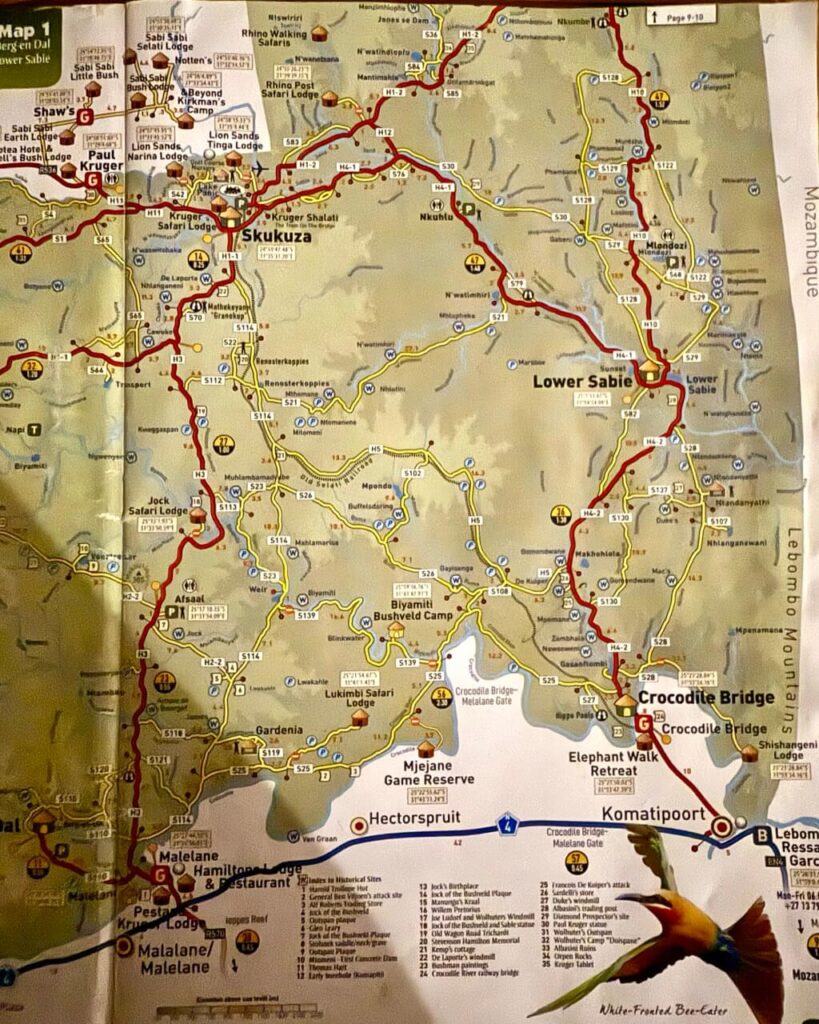
Here are some of the best self-drive routes in Kruger based on where you’re staying. They can all be done the other way round, e.g.,. From Lower Sabie to Skukuza. While the route given below is for the tar roads mostly (marked in red on the map above), feel free to go on other routes branching off of it. Head to the watering holes and pans (marked w and p on the map) and stop your car to observe animals come and go. Get back on the main tar road when done and follow the route.
Skukuza to Lower Sabie (46 km, 2.5 hours) and vice versa: This scenic road (H4-1) follows the Sabie River from Skukuza’s woodlands to the open grasslands of southeastern Kruger. It’s prime leopard territory, with good chances of spotting lions (we spotted lionesses and her cubs here) and hyenas near Skukuza. Stop at Nkuhlu Picnic Site for river views with hippos and crocs. Near Lower Sabie, look for cheetahs, rhinos, and large herds of grazers. Birders shouldn’t miss Sunset Dam.
Skukuza to Satara (93 km, at least 5 hours): For the best chance of spotting lions in Kruger, drive the Skukuza-Satara tar road (H1-2, H1-3), which transitions from river basin to central grasslands. Look for elephants near the N’watindlopfu River and big-game action around Satara, known for buffalo and lions. Stop at Tshokwane for food and refreshments, and stretch your legs at the Kruger Tablets get-out point.
Lower Sabie to Tshokwane (40 km, at least 2.5 hours): One of Kruger’s most scenic drives, the H10 offers sweeping views over the eastern grasslands and Lebombo mountains. Look for cheetahs, lions, hyenas, and large herds of grazers. Stop at Mlondozi Dam for birding, Nkumbe Hill (394m) for panoramic views, and the N’waswitsontso River basin for elephants. The Tshokwane area is rich in big game.
Lower Sabie to Crocodile Bridge Gate (36 km, 2.5 hours): The drive from Lower Sabie to Crocodile Bridge Gate is a wildlife-rich route along the Sabie River. The open grasslands and riverine bush are prime territory for lions, leopards, and large herds of elephants and buffalo. Look out for cheetahs in the more open areas and hippos and crocs along the river. Sunset Dam, just outside Lower Sabie, is a must-stop for birdwatching. In fact, our very first evening in this area, we saw leopards, lions, cheetahs, water buffalo, a lot of giraffes, zebras, impalas, you name it.
Tip: You can combine the routes above on a full day of exploring. For example, you can do Skukuza to Lower Sabie to Crocodile Bridge Gate in one day.
Self-Drive Kruger Itineraries and Budget
You should spend at least 3 to 4 days in Kruger National Park to get the best safari experience. A lot of people tend to stay even longer, but obviously that is not possible for everyone, especially if they’re travelling to South Africa on a short trip.
Your itinerary will completely depend on where you’re planning to stay and your budget:
- Budget: R1500–R3500 per person per day for camp stays at SANParks rest camps with self-drives and 1 or 2 SANParks arranged game drives.
- Mid-Range (lower-end): R4000–R6000 per person per day for a comfortable stay outside the park with a mix of SANParks – arranged game drives and self-drive safaris for a balanced experience
- Luxury: R15,000-100,000+ per person per day for exclusive all-inclusive stays and shared/private 9-seater safari experiences.
- Premium: This is a combination of a mid-range and luxury experience where you’ll be spending 1-2 nights in a mid-range lodge and 1-2 nights in a luxury all-inclusive hotel. This will enable you to experience both a self-drive and an exclusive safari experience. So your budget would vary between a mid-range and luxury experience.
I’ve written up detailed Kruger itineraries for all budgets so you can easily plan your trip.
Tip: If you’re renting a car and driving through Kruger, then you should also save at least half a day to drive the Panorama Route and see the largest green canyon in the world, Blyde River Canyon. It’s a beautiful drive with stunning viewpoints and waterfalls. You will not be able to see all these spots, so you’ll have to pick the best. I’ll suggest doing the following: Three Rondavels View Point, Bourke’s Luck Potholes (a bit of a trek), and Lisbon Falls. Then grab lunch at Harrie’s Pancakes in Graskop. The savoury pancakes we tried were delicious.
Food & Fuel Stops Inside Kruger
Where to Eat
Most major rest camps have restaurants and shops where you can dine or buy quick bites. Some of the top dining spots are:
- Cattle Baron (Skukuza) – Known to have the best steak in the park.
- Mugg & Bean (Lower Sabie) – Scenic deck with river views. We loved eating here!
- Tindlovu Restaurants – Available at several rest camps.
Where to Refuel
- Fuel stations are available at major rest camps, including Crocodile Bridge, Skukuza, and Lower Sabie.
- Always top up your tank whenever possible, as fuel stations are far apart!
Top Tips for a Successful Self-Drive Safari

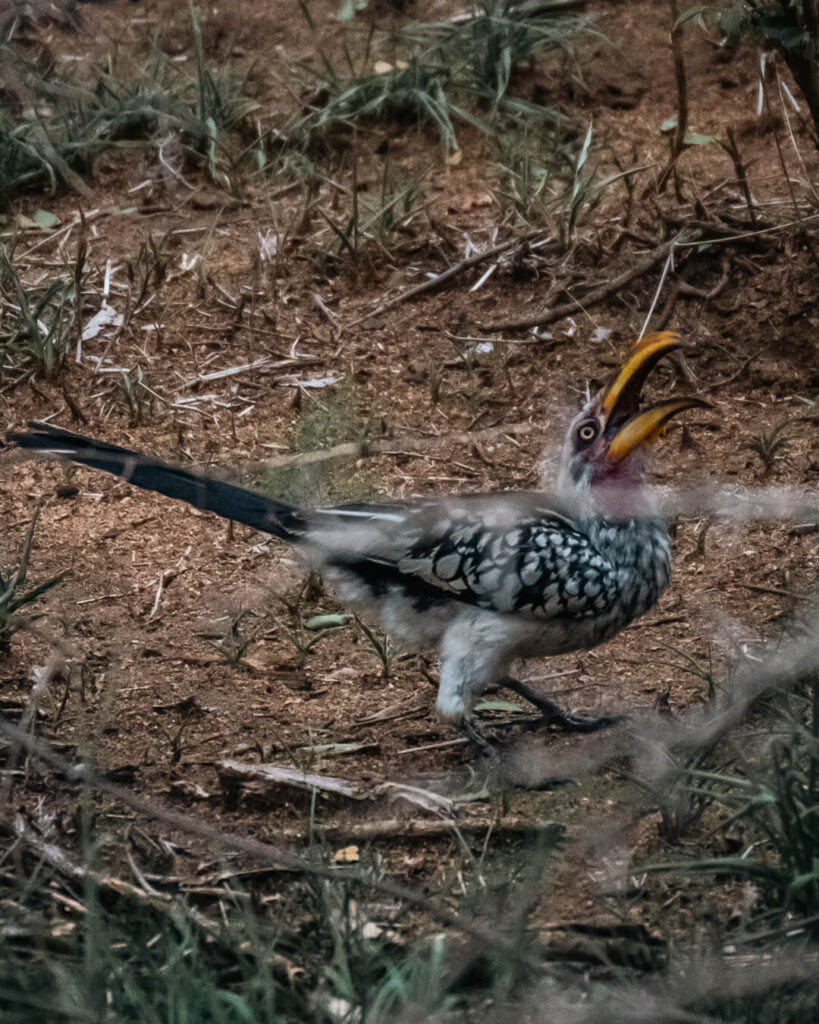
- Start early: Wildlife activity peaks early in the morning and in the evening, so that’s when you should be out exploring. You can queue up at the gate at opening time or opt to enter half an hour later, like we did, in case you don’t wish to queue up.
- Get Your Breakfast Packed: If you’re staying at a private lodge, ask them if they can pack your breakfast for your self-drive. Our lodge host graciously offered to pack a breakfast for us and that too a huge one that we literally ate all day. I’m sure other hotels provide this too, as self-driving in the park is the norm so do ask them for it.
- Drive Slowly: The speed limit is 50 km/h on tar and 40 km/h on gravel but you may need to drive even slower. It’s tempting to speed up when you don’t see anything, but patience is key. Animals blend into their surroundings, and if you’re driving too fast, you’ll miss the well-camouflaged leopard (trust me, it’s so easy) lazing behind a bush or a beautiful bird in the tree. The slower you go, the more you’ll see. And yes, it can get boring at times when you spot nothing.
- Chart out your main route: Chart out your route for your self-drive a day earlier so you know what you want to do. However, you don’t have to strictly adhere to it. Feel free to take other routes as well!
- Use maps to navigate: Use physical maps or Google Maps to navigate.
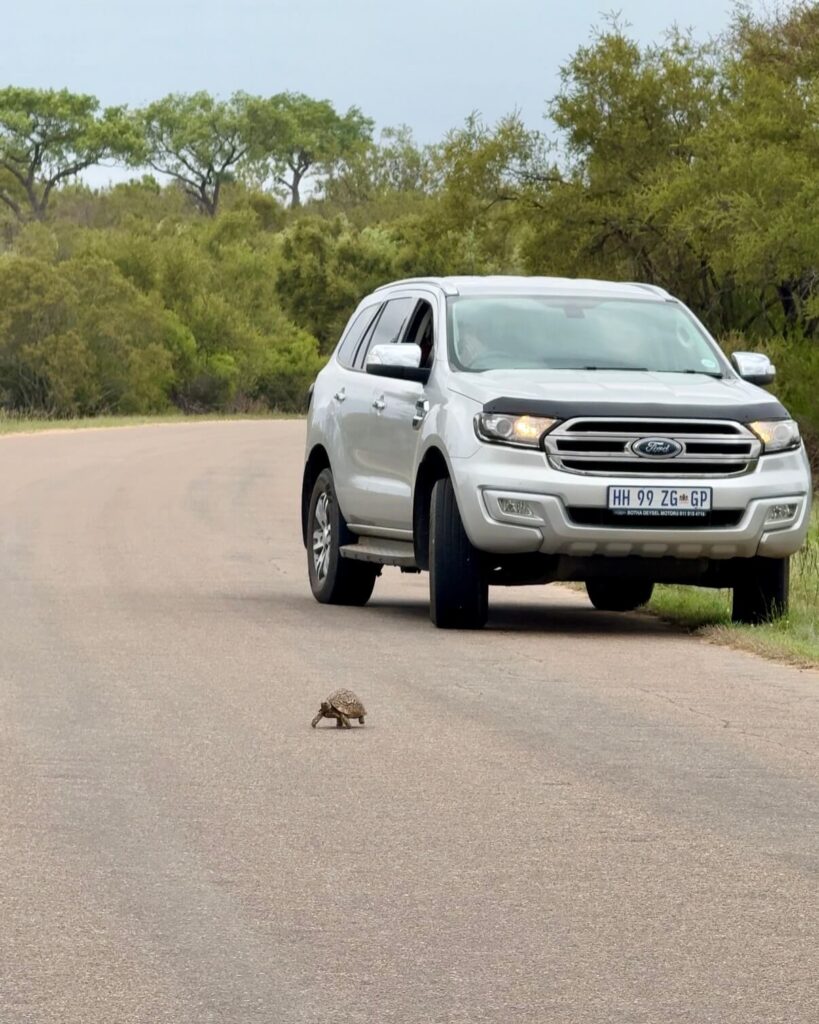
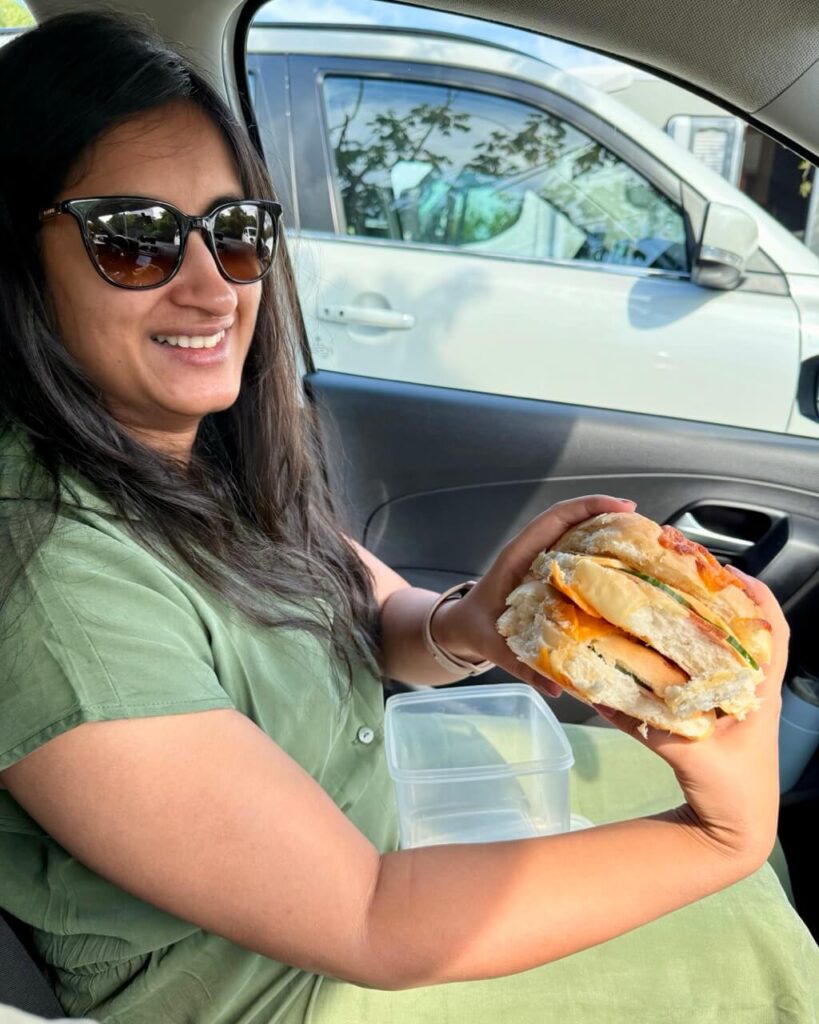
- Stop at Waterholes and Riverbanks: Some of the best wildlife sightings happen when you’re just sitting quietly by a waterhole. Look for waterholes on the map, drive to them, stop, turn off your engine, and wait. You might see elephants taking a mud bath, a pride of lions lazing nearby, or a crocodile lurking just beneath the water’s surface. Our favourite moment of our self-drive happened during such times!
- Make Use of Get-Out Points: Stop at the get-out points to refresh and walk around. We stopped at the Lower Sabie Rest Camp, grabbed a bite there, and really soaked in the beautiful view of elephants playing around in the river. It was wonderful. The toilets were clean and well-equipped too.
Remember that rest camps aren’t just for food and fuel—they’re mini information hubs. Most camps have sightings boards where visitors note down recent wildlife activity, which can help you plan your next drive. Plus, many have small museums or displays about the park’s ecosystem, adding depth to your safari experience. - Respect Wildlife (and Other Visitors): Never feed animals (it’s harmful to them and dangerous for you), don’t block the road at sightings, and always give animals the right of way. If a lion is sleeping on the road, enjoy the sighting from a safe distance—don’t honk or try to make it move! Also, keep noise levels low. Many people come to Kruger for the tranquillity of nature, so avoid blasting music, talking loudly, or revving your engine unnecessarily.
- Follow the safari jeeps: For good sightings, just follow the safari jeeps. Especially if you see a lot of them heading in the same direction. Chances are that a big cat has been sighted! The safari drivers all talk to each other and radio in, so always follow them.
- Use Binoculars: No matter what you think, if you’re doing a self-drive safari or opting for budget safaris, you will need binoculars to spot animals. Don’t wait to buy binoculars in the park, as they can be expensive. Do get it from home. They can cost a bit, but trust me, it’ll be worth it.
Must-know: It is possible for there to be traffic jams inside the park because of big cat sightings. This is a good thing because you’re finally seeing what you’re here to see, but bad because everyone made it too and blocked everyone’s way. It happens. Try not to honk if you’re stuck in one of these. You will need to be patient at such times but also ruthless enough to get the best spot to view the animal from.
What to Wear on a Self-Drive Safari in Kruger National Park?
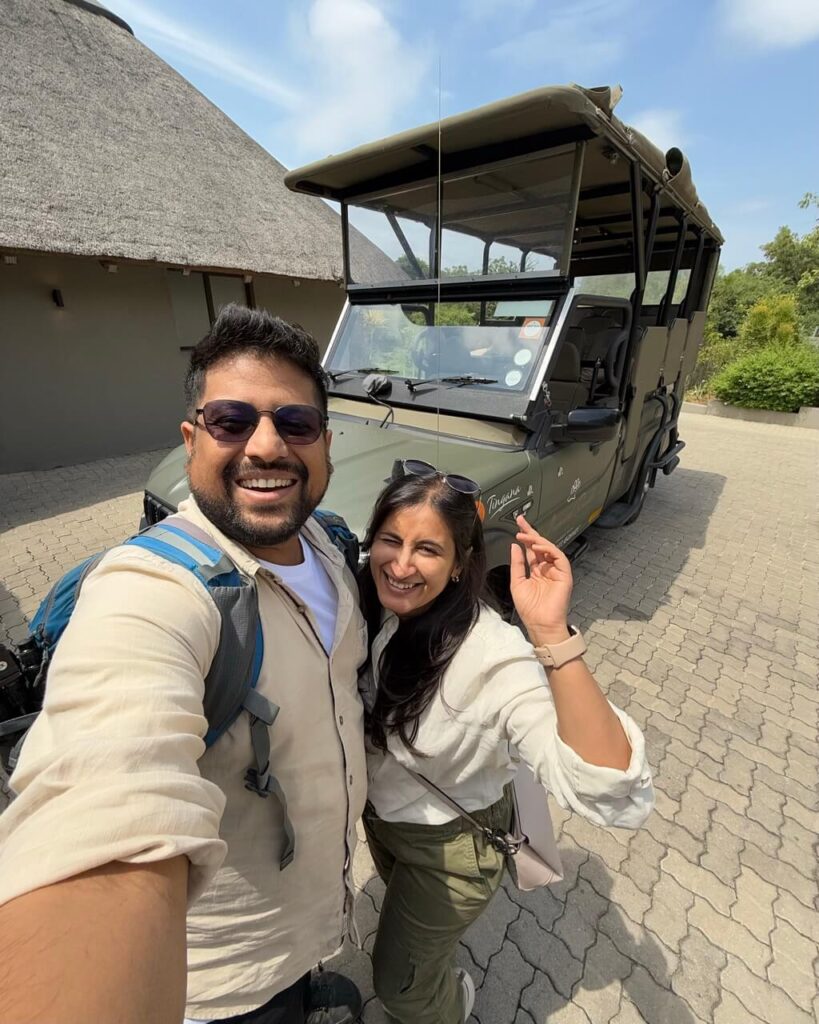

When heading on a safari, comfort and practicality are key.
- Stick to neutral colours like beige, khaki, brown, and olive to blend into the surroundings. A lot of people don’t follow this colour scheme in Kruger so it totally depends on you. Just avoid wearing bright colours like yellow, red, orange, and pink, which will really pop out. You don’t know how animals will behave on seeing these colours.
- Choose lightweight, breathable fabrics that will keep you cool during the day! It can get really hot (it was over 40 degree Celsius in the daytime when we were there)
- Long sleeves and trousers help protect against the sun, mosquitoes, and thorny bushes.
- It is said to avoid wearing dark blue and black, as these colours attract insects. However, we saw plenty of people wearing these colours too. On the self-drive safari, it won’t matter that much.
- Carry a light jacket or fleece even for the summer months, as it can be chilly in the mornings and evenings, especially when on a regular safari.
- Don’t forget your sunglasses to protect your eyes against the sun and spectacles for better visibility. Avoid wearing lenses, as dust gets into the eyes easily.
- Wear any comfortable shoes. While you can wear open-toed shoes for self-drives, it’s best not to.
- Carry a cap or hat (with a chip strap for a regular safari) to protect your face from the sun.
What to pack for Kruger?
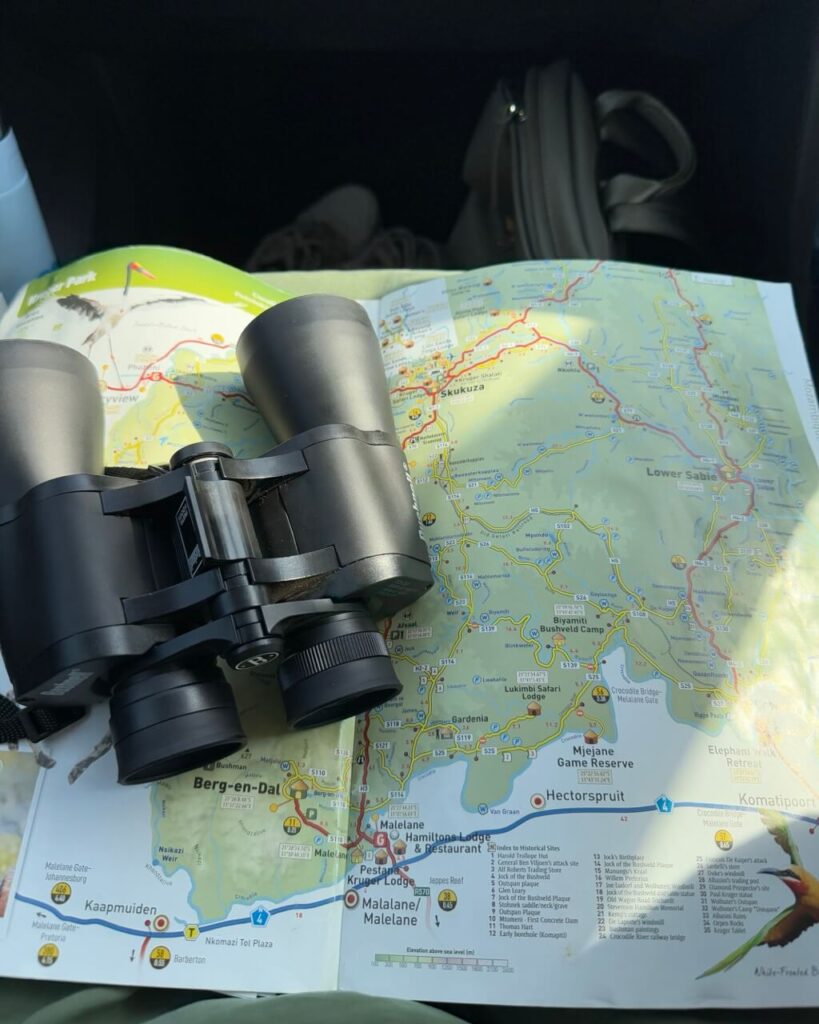
For a Luxury Guided Safari Experience
- Safari Clothes as listed above
- Sunscreen
- Camera with a telephoto lens (you can rent this from your hometown or even from Johannesburg)
For a Self-drive Safari
You will need to be very self-reliant for a self-drive experience. Don’t forget to carry the following:
- Safari Clothes as listed above
- Binoculars (do carry this)
- Insect repellent
- Sunscreen
- Snacks (get breakfast packed by your hotel)
- Camera with zoom lens (rent this at your hometown or even in Johannesburg)
- Map (or download Google Maps for the area)
- Litter bag (for your snack packets)
Driving through Kruger on your own is honestly such a cool experience—there’s nothing like the thrill of spotting wildlife at your own pace! With a bit of planning, you can have an epic safari experience. Whether it’s your first lion sighting or just soaking in the quiet moments with elephants by a watering hole, Kruger has a way of making you fall in love with the wild. So grab your snacks, take it slow, and enjoy the ride—this is one adventure you won’t forget!
This blog post on ‘Self-Drive Kruger National Park’ has affiliate links that enable us to earn a small commission when you make a purchase, with no extra cost to you. We only recommend products that we like and those that might interest you. If you like any suggested product, do buy from the given links.

